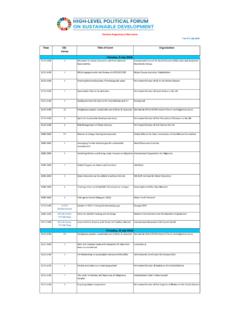Transcription of A HEALTH FINANCING REVIEW OF VIET NAM
1 A HEALTH FINANCING REVIEW OF viet NAM. WITH A FOCUS ON SOCIAL HEALTH INSURANCE. Bottlenecks in institutional design and organizational practice of HEALTH FINANCING and options to accelerate progress towards universal coverage August 2011. by Tran Van Tien, Hoang Thi Phuong, Inke Mathauer and Nguyen Thi Kim Phuong Table of contents List of tables .. ii List of ii iii Acknowledgement .. iiv 1. Introduction .. 1. 2. Overview of the HEALTH FINANCING system of viet 4. The structure of the HEALTH care system .. 4. HEALTH FINANCING policies and the evolution of social HEALTH 6. Resource mobilization and HEALTH expenditure .. 9. 3. HEALTH insurance in viet Nam: institutional design, organizational practice, and challenges .. 13. Social HEALTH insurance enrolment and collection of contributions .. 14. Pooling of 22. Purchasing .. 24. HEALTH insurance benefit package and financial risk protection.
2 24. Purchasing structure and provider payment mechanism .. 26. 4. Summary of the HEALTH FINANCING performance assessment .. 35. 5. Conclusions and 38. References .. 42. List of tables Table 1. Indicators of HEALTH FINANCING performance .. 2 Table 2. Current HEALTH insurance membership categories .. 16 Table 3. HEALTH insurance coverage 2010, by mode of 20 Table 4. Share of total SHI contributions by membership 21 Table 5. Capitation rates of the six SHI membership groups in Kien Giang Province, 29 Table 6. Actual achievement in HEALTH FINANCING performance indicators .. 35 Table 7. Catastrophic expenditure and impoverishment by socioeconomic status, 37. List of figures Figure 1: The structure of the HEALTH care system in Vietnam .. 4 Figure 2: Channels of FINANCING sources for the viet Nam HEALTH care system .. 8 Figure 3: Per capita HEALTH expenditure in viet Nam (US$ current prices ), 1998 2008.
3 9 Figure 4: Share of sources of total HEALTH expenditure in 10 Figure 5: Tax-based FINANCING for HEALTH (in current and constant prcies) during 2002 2008 11 Figure 6: Trend in HEALTH FINANCING , 1999 - 2008 .. 12 Figure 7: Government expenditure for HEALTH (excluding SHI expenditure) compared to total HEALTH expenditure and total government 12. Figure 8: Membership group share, their contribution and expenditure share (2010).. 38 Annex Figure 1: Overview of the analytical ii Abbreviations CHS commune HEALTH station DRG diagnosis-related group FFS fee for service GDP gross domestic product GGE general government expenditure GGHE general government HEALTH expenditure INN international nonproprietary name MoH Ministry of HEALTH MOLISA Ministry of Labour, Invalids and Social Affairs NHA national HEALTH account OOP out-of-pocket (payment). PHI private HEALTH insurance PPC Provincial People's Committee SHI social HEALTH insurance THE total HEALTH expenditure VND Vietnamese dong (currency).
4 VSS viet Nam Social Security WHO World HEALTH Organization iii Acknowledgement We thank the Ministry of HEALTH (MOH) who approved and supported this study. We likewise are very grateful to MOH and VSS officials for their collaboration and fruitful discussions of HEALTH FINANCING issues. We extend our gratitude to WHO Representative of Vietnam as well as the whole WHO Country Office team for their great assistance both technically and organizationally. Finally, thanks are extended to all respondents from the different organizations and departments who shared their insights and views on the Vietnamese HEALTH FINANCING system. Valuable research assistance was provided by Friedrich Wittenbecher iv 1. Introduction Rationale and objectives of this report Many countries are working to establish a HEALTH FINANCING system that allows them to move towards universal coverage defined as access to key promotive, preventive, curative and rehabilitative HEALTH interventions for all at an affordable cost thereby achieving equity in access and financial risk protection as well as in HEALTH FINANCING (WHO, 2005).
5 This is particularly challenging for low- and middle-income countries in light of their heavy reliance on out-of-pocket (OOP) payments for HEALTH care (WHO, 2010). The challenge is to improve the HEALTH FINANCING system in order to achieve universal coverage as an overall policy goal. The Government of Vietnam is clearly committed to universal coverage and has approved a number of important laws relating to HEALTH FINANCING and HEALTH insurance. In addition to some good HEALTH indicators, there are impressive achievements as to Vietnam's HEALTH FINANCING , namely a population coverage rate of about 60%, continuous commitment to state subsidized premium payments, and developments in the payment system. viet Nam's HEALTH FINANCING policy puts a strong emphasis on equity in HEALTH . Shifting from a tax-based HEALTH FINANCING system, viet Nam has been introducing social HEALTH insurance (SHI) since 1992.
6 The country's HEALTH insurance law was promulgated in 2008, with the goal of universal coverage by 2014. Yet, the goal of universal coverage with SHI is challenging. As in other developing countries, the majority of viet Nam's population works in the informal sector. The share of household out-of-pocket (OOP) payments for HEALTH , despite its rapid decrease in recent years, is still very high and accounts for some 55% of total HEALTH expenditure (THE). Despite these successes and achievements, there are a number of bottlenecks in institutional design and organizational practice. These impede Vietnam from achieving the levels of HEALTH FINANCING performance that the country could potentially attain, given its resources and priorities, and are therefore of great concern with regard to achieving universal coverage. Based on the application of the OASIS1 approach (Mathauer/Carrin, 2011), this report describes the findings of an assessment of the current HEALTH FINANCING system in viet Nam.
7 The report provides a detailed analysis of viet Nam's HEALTH FINANCING system by assessing the system's institutional design and organizational practice i n relation to the key HEALTH FINANCING functions of resource collection, pooling and purchasing and how these affect the performance of the system. On this basis, it is 1. OASIS: Organizational assessment for improving and strengthening HEALTH FINANCING ; a practical tool for HEALTH FINANCING REVIEW , performance assessment and options for improvement. 1. possible to identify appropriate changes in institutional design and organizational practice that contribute to progress towards universal coverage. The remainder of Section 1 outlines the analytical approach and methodology of this work. Section 2 provides a brief outline of the HEALTH FINANCING system in viet Nam, while Section 3 gives a detailed institutional organizational analysis of viet Nam's HEALTH FINANCING system and assesses its performance.
8 The concluding section proposes policy options and changes in institutional design and organizational practice aimed at improving the performance of the HEALTH FINANCING system. Analytical approach and methodology The analytical framework underlying this study was taken from Mathauer &. Carrin (2011) and focuses on two core elements: i) the role of institutional design and organizational practice, and ii) the operationalization of HEALTH FINANCING objectives into HEALTH FINANCING performance indicators, as outlined in Annex Figure 1. Table 1. presents these indicators with their detailed operationalization and guidance on how these indicators could evolve in progressing towards universal coverage in a low middle-income country such as Vietnam. These indicative targets are based on the core values of equity and social justice, as well as on the rationale of using resources as efficiently as possible.
9 The operationalization described below also takes account of the often limited availability of data in low- and middle-income countries. Table 1. Possible indicators of HEALTH FINANCING performance HEALTH FINANCING performance Guidance for indicative targets indicator and operationalizations 1. Level of funding - THE per capita for low and lower middle-income income countries - THE/GDP ( , the existing resource mobilization potential is realized). - GGHE/THE. Average THE as a share of GDP in lower middle- - GGE/GDP (fiscal space) income and low-income countries is and respectively (Durairaj, 2010). - GGHE / GGE (fiscal space for HEALTH ). 2. Level of population coverage - Percentage of population covered by a 100%. financial risk protection mechanism. Equal population coverage across quintiles or (This means that a person is not put at population groups. financial risk due to the costs of care.)
10 3. Degree of financial risk protection - Government funds prepayment ratio: 70%. GGHE/THE. 2. HEALTH care payments are at or exceeding 40% of a household's capacity to pay in any year (Xu et al., 2005). 2. - Percentage of households experiencing 0%. catastrophic expenditure in each 2. scheme 4. Level of equity in HEALTH FINANCING - Total and specific HEALTH FINANCING HEALTH FINANCING payments as a share of non-food payments ( taxes, contributions, consumption is equal across all households. insurance premiums, co-payments, out- of-pocket expenditure for HEALTH ) as a share of household income 5. Level of pooling across the HEALTH FINANCING system - HEALTH care spending per pool member Equal HEALTH care spending per pool member across set in relation to overall HEALTH risks of pools when set in relation to HEALTH risks of pool pool members members. 6. Level of operational efficiency and equity in the delivery of a given benefit package at a given level of quality standards3.












